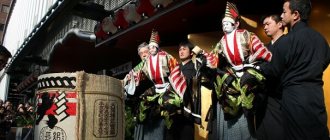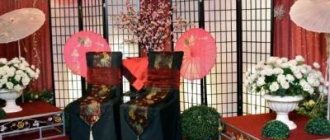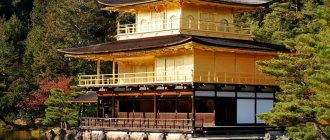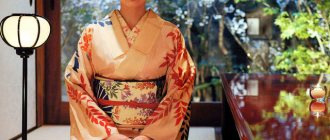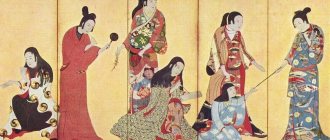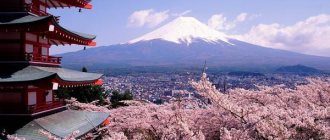Patriarchy in the family
In the modern Japanese family, patriarchal foundations and traditions are not so strong, but are still preserved. Men are always the head of the family, and women take care of the housework and raising children. The roles of men and women are clearly divided:
- Wife submits to her husband
- Daughter to father
- If the mother is widowed, then the son
Younger people treat their elders with special respect and reverence. Women to men, and they take care of and protect them. A wife always tries to please her husband. All holidays are celebrated with family. For the Japanese, family is something sacred .
The head of the family can calmly spend time in various massage parlors and brothels. Japanese women are raised in such a way that their husband’s affairs on the side are not considered treason. Even if a drunken husband is brought home by geishas or dancers, the wife bows to them, thanking them for bringing them home and treating them.
Holidays with family
The Japanese are accustomed to celebrating the most important celebrations by surrounding themselves with those closest to them. It is not surprising that, in addition to the usual weddings, birthdays and New Year, each family member has his own day of the year.
Any holiday is accompanied by warm smiles, words of gratitude, gifts, a tea ceremony and a feast.
Wedding
Getting married is a big event. They begin to prepare for it at least six months in advance: they send out invitations, prepare outfits, agree on the location of the ceremony - usually this is a special wedding center, where they can conduct the ceremony according to the canons of Shintoism, Buddhism or Christianity.
Special kimono outfits are prepared for the bride and groom. An integral attribute in the image of a bride is a wig, similar to a hood, which is designed to hide the “horns” that appear on a girl when she is excessively jealous. The fact is that jealousy here is considered a huge flaw that causes shame.
This is interesting!
The average age of a Japanese groom is 31 years old, the bride is 28 years old.
European trends make themselves felt even in wedding fashion, so modern brides often move away from blindly following traditions. But all the same, the spirit of Japan will be felt in any wedding.
New Year
New Year's holidays are a great occasion to get together with a big, friendly family. Even those who live far away gather with their parents. The whole group of households decorate the house with kadomatsu - pine or bamboo at the entrance, fancifully decorated with rope, ferns, citrus fruits, and algae.
New Year begins when the bells ring one hundred and eight times. Buddhist philosophy says that the ringing of bells cleanses one hundred and eight passions that overcome a person. New Year's dinner is calm, quiet, cozy.
Girls' Day
At the beginning of March, girls are congratulated. All houses display collections of luxuriously dressed ceramic dolls, which become family heirlooms.
When a girl is born, they buy her similar dolls, and give her more throughout her life. So, before marriage, a girl has a collection of more than fifteen dolls. They instill a sense of beauty, teach good manners, and develop good character traits.
Children's Day
Or rather, boys. Similar to traditions on Girls' Day, on May 5, warriors' equipment, swords, uniforms, and figurines of soldiers are placed around the house, and images of carps, a symbol of vitality, are hung near the house.
Boys under fifteen years old accept congratulations, wishes for strength, courage, good luck, and valor.
Mothers Day
In the first ten days of May, beloved mothers receive respect and love. They are given everything that women might like: from blouses, wallets and sweets to kitchen utensils and appliances.
Father's Day
Workaholic fathers were also not spared. The third Sunday in June becomes an occasion to once again thank dads. Red roses are presented to dads, and white roses are presented to the graves of dead fathers.
Children in a Japanese family
Nothing is prohibited for children under 5–6 years old; they are not raised their voices or punished. Raising children is based on the example of parents' behavior in the family. The mother is always next to the child, talking to him and explaining everything. That's why children in Japan start talking before they can walk. A woman who takes care of her career rather than her child is condemned by society. Children under 12, sometimes up to 16 years old sleep with their parents. A father with his children of both sexes can take a bath, even if his daughter is already 20 years old. This is normal for a Japanese family. From childhood, girls are taught obedience and respect for men, and are prepared to be an ideal wife and mother.
Unusual traditions of Japan
Among the unusual traditions of Japan, it is worth highlighting the most interesting. These include:
- New Year at dawn. The country's population does not celebrate the New Year the way Europeans or Americans do. On New Year's Eve, people go to bed, and in the morning they begin to greet the dawn with the whole family.
- They don't say the word "no". It is not customary for people to refuse a person and say the word no. They replace it with another polite phrase and try to move away from the topic so as not to offend the person.
- No jokes. Japanese people don't have jokes, but these people have an interesting sense of humor.
- Don't forget about the business card. In the Land of the Rising Sun, it is considered indecent to leave home without a business card. They carry it everywhere, even taking the business card with them to the pool and placing it in a waterproof handbag.
- A moment of politeness. It is not customary for the Japanese to shake hands when meeting each other. Instead, people bow.
- Transport oddities. The subway employs specialists called pushers. They push people and pack them into carriages.
- Oddities of schoolchildren. Girls are not allowed to interact with boys until a certain age. Students should not walk alone. This is considered an immoral act.
- No address. Many streets in cities do not have names. Houses are indicated descriptively or by number within the block.
- Fear of twins. In ancient times, when twins were born, one of them was called the son of a demon. Therefore, just in case, they got rid of both children, as well as their mother.
- Family budget. The woman manages all family finances. The husband has no right to even ask about money or purchases.
- Anti-etiquette rules. While eating, you need to smack and slurp, but you cannot move dishes, eat bitten pieces of cake, pierce food with chopsticks, and also use a spoon or pour your own lunch.
An equally interesting tradition in Japan is the adoption of adult boys. This is due to the fact that the mother and father wish to pass on their surname. Therefore, adoption of the daughter's husband is appropriate.
Older generation in a Japanese family
In Japan, since ancient times, several generations lived under one roof, the oldest man was the head, and everyone obeyed him. In a modern country, grandparents live separately in their own house, apartment or nursing home. Moreover, if everyone in the family works and there is no one to look after the elderly, they are taken there in the morning and taken home in the evening. The nursing home provides care and supervision for pensioners. Old people will be entertained and fed, and they will also have the opportunity to socialize with their peers. This is a “kindergarten” for the elderly.
National traditions of Japan
Since ancient times, the country has preserved a huge number of rituals and customs that are observed by the people today. This applies to almost all areas of life. It’s difficult to briefly talk about Japanese traditions, since there are so many of them. Remain unchanged since the Middle Ages :
- tea ceremony;
- family rituals;
- features of hospitality;
- sexual traditions and others.
The Japanese treat the surrounding nature with care and great love, admiring its naturalness, weather phenomena, flowers and the sea.
Kindergarten
A Japanese mother, as a rule, stays at home until the age of 3, raising her baby. After this, the child is sent to kindergarten. There are nurseries in Japan, but it is not advisable to send children there. A mother who sends her child to a nursery and decides to start working is considered selfish. The Japanese claim that in this way she satisfies her personal interests, and not the interests of her family.
There are public and private kindergartens in Japan. State nurseries accept children aged three months and older. The kids are there from 8 a.m. to 6 p.m. But sending a child to such a kindergarten (called Hoikuen) is not so easy; you need a serious reason. Payment for these institutions depends on the level of family income.
Etien is another type of kindergarten. Babies are sent here for 7 hours a day (from 9:00 to 14:00), and the mother works no more than 4 hours a day. There are also special - prestigious kindergartens. They cooperate with famous universities. Getting into such a kindergarten is a great success for a child, because after graduating, he immediately goes to a university school, and from there to the university without passing exams. A diploma from a higher educational institution is the key to a prestigious and highly paid job. However, enrolling in such a kindergarten is not so easy; parents need to pay a decent amount, and the child needs to successfully pass difficult testing.
Education of preschoolers can be divided into several parts:
- language;
- expression of feelings;
- safety and health;
- relations in society;
- the world.
Japanese educators strive to raise a healthy child who is developed in various areas and loves his country. In kindergartens they teach writing, reading and singing. Sports competitions and hikes are often held. All activities are aimed at assimilating a sense of collectivism. A great way to develop endurance in children and explore the area where they live is a hike that lasts more than one day. In addition, children are instilled with a love of nature from a very early age, and bright holidays and festivals are held in honor of any natural phenomena and plants.
Basic principles of the Japanese worldview
Japanese children, already at preschool age, learn the principle that everything in this world has its place. This is not always easy for kids. So it is hardly necessary to transfer their customs to us.
In general, a family of 4 people is considered the norm. The main one is the father or shujin . The wife plays the role of a housewife. It is called kanai , which means "inside the house". Now this division is gradually smoothing out and more and more women are going to work. Much attention is paid to the birth order of children. The eldest is the heir. He is responsible for most of the responsibilities.
The situation with marriages is interesting. More often, parents themselves agree on the wedding of their children and find life partners for them. Fortunately, this rule is gradually disappearing into oblivion. Divorce is not welcomed in society and happens extremely rarely.
Japanese culture video
The video tells about interesting facts about the land of the rising sun.
This article will be useful when creating a presentation about Japanese culture
.
The unique, but very specific, even peculiar culture, together with the special worldview of the Japanese, is determined by their isolated and seemingly “closed” geographical location. Their country is distinguished by special climatic conditions and has some relief features, which, in turn, affect the place of residence. Endless disasters, such as earthquakes, tsunamis and volcanic eruptions, forced these people to sacredly revere nature and treat it as if it were a living being. The centuries-old and fierce struggle for survival could not but leave its mark on all the customs and traditions of Japan.
What is also striking is the variety and huge number of different rituals with traditions, which are mandatory here in terms of execution, or, at best, recommended. The entire life of the aborigines of this state is intertwined, as if by an invisible web, with ceremonies and a set of traditions. Each area of life in this country has its own rituals and traditions.
Since the distant times of the Middle Ages, all kinds of Japanese interiors with clothing have remained unchanged, as well as the language of the Japanese, which has not changed significantly throughout the centuries-old and eventful history of this ancient people. From ancient times to this day, the ceremony of contemplation has been an integral part of the life of society here. To look, to observe, in other words, the Japanese contemplate any natural phenomenon, be it flowering trees or the full moon, the rough sea or the falling of autumn leaves.
Are there any taboos regarding communication?
There are some things that are taboo in Japan. We are talking about the following: too close a distance during a conversation; familiar attitude; active and sweeping gestures when speaking; A direct gaze during a conversation will be perceived by the Japanese as aggression.
Advice
Other Japanese traditions are also unique. In particular, handshakes are not accepted here at all, and you are supposed to greet each other with a bow, and with the same intensity and with the same respect as the greeting you received.
Brief description of Japanese culture
The culture and worldview of the Japanese population were greatly influenced by the location of the country, climatic features and relief features, and in addition constant natural disasters (earthquakes and tsunamis), which was reflected in the special veneration of the Japanese for the surrounding nature as a living being. The ability to admire the momentary charm of nature is a characteristic feature of the Japanese mentality, and is reflected in Japanese creativity.
Japanese language and writing.
The Japanese language has always been an important part of Japanese culture. Japanese is an agglutinative language and is characterized by a difficult concept of writing, which is formed from three different types of characters - Chinese kanji characters, katakana and hiragana syllables.
Literature of Japan in brief
For a long time, Japanese literature was influenced by the Chinese Empire, and works of literature were also written in Chinese.
The first examples of Japanese literature are the collection of Japanese tales and myths "Kojiki" ("Writings about the deeds of antiquity") and the historical records "Nihon shoki" ("Brush-written Annals of Japan" or "Nihongi" - "Annals of Japan"), which were created in Nara era (7th - 8th centuries). At the same time, the poetic anthologies “Manyoshu” (“Collection of Myriad Leaves,” 759) and “Kaifuso” were written.
The types of poetic styles haiku, waka and tanka are also popular outside Japan.
Haiku by the famous Japanese poet Basho:
The flowers have faded.
The seeds are scattering and falling,
It's like tears...
Cinema
At first, in Japan, cinema was considered an unworthy art, and there was a disdainful attitude towards the people who made films. Cinema became popular only in the late 30s of the 20th century.
In the 50s and 60s of the 20th century, Japanese cinema began to actively develop. This period is called the "golden age" of Japanese cinema. In 1950, 215 films were produced, and in 1960, their number reached 547. At the same time, the genres of political, historical cinema, science fiction and action films spread, and Japanese cinema became famous throughout the world. Famous directors of that time were Akira Kurosawa, Shohei Imamura, Kenji Mizoguchi. Actor Toshiro Mifune, who played in almost all of Kurosawa's films, is gaining great popularity outside of Japan.
In the 90s of the last century, director and actor Takeshi Kitano became known throughout the world.
"Seven Samurai" by Akiro Kurosawa, which in 2010 took first place in Empire magazine's list of "100 best films of world cinema"
Anime and manga
Anime (Japanese animation) is widely known throughout the world. Anime differs from other animated genres in its greater focus on adult viewers. Anime has an auxiliary division into genres for a specific target audience. The measure for separation is the age, gender or psychological profile of the movie viewer. Anime is often a film adaptation of Japanese manga comics, which have also gained great popularity.
The main part of the manga is intended for an adult audience. As of 2002, approximately 40% of the total book market in Japan is occupied by manga comics.
Anime "Princess Mononoke", 1997
Cloth
In Japan, there are two types of clothing - national - wafuku, and ordinary European, which is worn in everyday life. Kimono (translated as “clothing, outfit”) is the general name for any clothing in the broad sense, and in the narrow sense it is a form of wafuku.
Yukata - light robe;
hakama—pants;
geta, waraji - sandals;
obi - belt.
Geisha kimono
Traditions, customs, etiquette
Japanese society is characterized by a clearly expressed sense of belonging to a specific social class (family, work team, student group), which is also manifested in peculiar connections within the community.
In Japan, the concepts of “duty” and “obligation,” called giri, are of particular importance. Despite the fact that kettlebells are a universal social norm for Japanese behavior, in some situations, particularly among young people, kettlebells are not taken so seriously.
In Japan, there are certain norms of gestures, and the more reserved a person is, the more respectful he is treated, so a friendly tap on the shoulder and tugging on the hand will not be welcomed in the land of the rising sun.
Theater and dance. Japanese culture in brief.
The very first type of theater was the Noh theater, which was formed in the 14th-15th centuries; when playing in it, the actors put on masks and dressed in luxurious attire. In the 17th century, one of the most famous types of national theater in Japan, kabuki, was created; complex makeup was applied to the actors’ faces. The skill of onnagata, the actors who play the role of a woman, is especially appreciated. In 1629, the Tokugawa shogunate banned women from playing kabuki, after World War II women began to appear on stage again, and even the first all-female troupe was created.
The national bunraku puppet theater is also famous. Certain playwrights, such as Chikamatsu Monzaemon, created plays for bunraku, which were later performed in the “big theater” - kabuki.
Kabuki theater
Women's Kabuki Troupe
Bunraku doll
Video
This is also interesting:
Unusual and interesting holidays of Japan that we do not understand The mysterious people of Aina - the secrets of Japan What do you know about Tokyo - the capital of Japan? Facts about Japan or the pros and cons of the Land of the Rising Sun
The culture of Japan was formed through a historical process that began with the migration of the ancestors of the Japanese to the Japanese islands from the continent and the founding of the Jomon culture. Japan's current culture is influenced by Asian countries (particularly Korea and China), North America and Europe.
Funeral
Funerals are considered one of the unusual rituals in Japan. The lips of the deceased are moistened with water, and a special knife is placed on the chest - a symbol that drives away evil spirits. A table with flowers and a scented candle is placed near the deceased’s bed. The body is washed and funeral makeup is applied. Women are dressed in kimonos, and men are buried in a business suit. The deceased's belongings and 6 coins are placed in the coffin with him. The money is the payment for crossing the Sanzu River of the Dead.
It is customary to provide financial assistance to the family of the deceased. Money is brought in envelopes decorated with mourning flowers. The amount depends on how close the deceased was to the guest. The deceased is said goodbye the day after the funeral service. This takes place in a Buddhist temple. As a sign of grief, when saying goodbye to a person, guests place flowers on his shoulders and head.
The priest gives the deceased person a new name, which should protect the deceased from the call of the living. After the ceremony, the coffin with the body is taken to the crematorium in a hearse. In Japan, cremation is considered the most common method of burial. The relatives of the deceased silently watch as the body of the deceased is placed in the crematorium oven.
The ashes of the deceased are transferred to the urn using large steel sticks. The ashes of the lower part of the body are laid first, and the upper part last. The location of the remains should not be disturbed even in the urn. Funerals will take place in a regular family burial site in a cemetery or in a gravesite on a corporate plot.
Relationships in the team
Groups in Japanese kindergartens are small: 6 - 8 people. And every six months their composition is reorganized. This is done in order to provide children with greater opportunities for socialization. If a child does not have good relationships in one group, then it is quite possible that he will make friends in another.
The teachers are also constantly changing. This is done so that children do not get used to them too much. Such attachments, the Japanese believe, give rise to children's dependence on their mentors. There are situations when some teacher dislikes a child, but a good relationship develops with another teacher.
What classes are offered in kindergarten? Children are taught to read, count, write, that is, they are prepared for school. If the child does not attend kindergarten, such preparation is carried out by the mother or special “schools” that resemble Russian clubs and studios for preschoolers. But the main task of a Japanese kindergarten is not educational, but educational: to teach the child to behave in a team. In later life he will have to constantly be in some kind of group, and this skill will be necessary. Children are taught to analyze conflicts that arise in games. At the same time, you should try to avoid rivalry, since the victory of one may mean the “loss of face” of the other. The most productive solution to conflicts, according to the Japanese, is compromise. Even in the ancient Constitution of Japan it was written that the main dignity of a citizen is the ability to avoid contradictions. It is not customary to interfere in children's quarrels. It is believed that this prevents them from learning to live in a group.
Choral singing occupies an important place in the education system. According to Japanese ideas, singling out a soloist is not pedagogical
And singing in chorus helps foster a sense of unity.
After singing, it’s time for sports games: relay races, tag, catch-up. It is interesting that teachers, regardless of age, participate in these games along with children.
About once a month, the entire kindergarten goes on a full-day hike around the neighborhood. The places can be very different: the nearest mountain, a zoo, a botanical garden. On such trips, children not only learn something new, but also learn to be resilient and endure difficulties.
Much attention is paid to applied creativity: drawing, appliqué, origami, oyachiro (weaving patterns from a thin rope stretched over the fingers). These activities perfectly develop fine motor skills, which schoolchildren need to write hieroglyphs.
In Japan, children are not compared to each other. The teacher will never celebrate the best and scold the worst, will not tell parents that their child draws poorly or runs the best. It is not customary to single someone out. There is no competition even in sporting events - friendship or, in extreme cases, one of the teams wins. “Don't stand out” is one of the principles of Japanese life. But it does not always lead to positive results.
Interesting Facts
- Japan has a high population density. This is a small state located on more than 6,000 islands. 127 million people live here.
- Increased workaholism. In terms of living standards, Japan is one of the top ten countries in the world. The success of the residents lies in their workaholism. They work for the same company all their lives. Work takes up 99% of the average Japanese person's time.
- Country of traditions. Japan has maintained its monarchy to this day. The symbol of the unity of the people and fidelity to tradition is the emperor.
- Amazing metro. It is not allowed to talk on the phone here. There are women's carriages in the country so that men do not pester.
- Suicide forest. There is a forest near Fuji. People come here to say goodbye to their own lives. Over the course of a year, more than 100 bodies are found in the forest. The cause of suicide is burnout at work and internal loneliness.
- Unusual clothes. Women and men wear kimonos on special occasions. Geisha and maiko dress up in this type of attire. Men wear kimonos to weddings when they welcome guests for tea.
Particularly interesting is the use of water procedures. For this purpose, an ofuro bath is used. The bathtub has a square shape and great depth so that the water covers the shoulders. Therefore, the bather has to sit with his knees bent, resting on his chest. Ofuro today is used mainly for physical and spiritual relaxation.
Japan will always attract the attention of foreigners because it is very different with its unusual and interesting traditions.
Kindergartens in Japan
The Japanese do not have to send their children to kindergarten, but some modern mothers strive to combine family and work, so they see no other option for their children. There are free and paid preschool institutions. It’s not easy to get into the state garden (opening hours from 8 a.m. to 6 p.m.). There are waiting lists and parents must provide compelling reasons for their child to attend. Private gardens are open from 9 to 14 (15) hours. The children have lunch there, but do not sleep.
The furnishings in the gardens are modest. Each group of 6-8 people is provided with a separate room. It is a play area and a bedroom: at the right time, children take out mattresses and lie down on the floor. This is where the kids eat. The menu contains rice, protein and dairy products, and calorie content is carefully calculated.
Education in kindergartens is not given enough time. Children are taught more important things in Japanese life: manners, the ability to express respect, rules of politeness, national rituals. Many things that are required in municipal kindergartens are given to children by parents, signed with a marker. Among them:
- a packed bento box with rice (there are gardens where the meals are entirely on the shoulders of the parents, there are mixed meals - some are prepared by the parents, some are offered by the garden);
- hand towel;
- futon mattress and bed linen (taken away on weekends for washing);
- pajamas;
- swimwear (in summer, if sea procedures are planned);
- visit diary and notebook for communication with parents.
Differences in kindergarten operating patterns in Japan depend on population density, location, and other factors. The groups are divided by age, but the kids walk together without offending each other. When choosing a preschool institution for a child, mothers look not only at the operating hours, but also at the location, requirements and teaching staff. When comparing Japanese and Russian gardens, it turns out that in the former there is more training, and in the latter there is more freedom.
Personal hygiene and cleanliness
The Japanese are very clean. Personal hygiene comes first. However, all family members take a bath in turn, without changing the same water, starting with the eldest. Guests are given primacy. If the size of the bath allows, then 2-3 family members bathe together. This water is then used for washing.
In many public places and restaurants, you need to change into slippers when visiting. Socks must be clean and intact. There are slippers at the entrance to any toilet. The Japanese are changing their shoes at a fast pace.
Modern Japanese traditions
Many ancient customs and rituals of Japan are gone, giving way to new ones. They are useful to know if you are going to visit the country and not find yourself in an awkward situation.
- In Japan, you can't point your finger, it will be considered disrespectful. If you want to show something, do it with an open hand.
- Handle business cards with respect. For the Japanese, this is not just a piece of paper with a phone number, but an important thing, one of the components of their culture. Having received a business card, you should look at it with interest, study all the information and carefully put it away in the business card holder.
- In Japan, it is not customary to eat on the go. Even if you bought food at a street cafe, sit down somewhere or eat while standing.
- Leaving a tip in Japan is bad manners. This will only offend the employee.
- If your mobile phone rings on the street or in a public place, you should keep the conversation as quiet as possible so as not to embarrass those present.
- Before going to the bathroom, you need to wash yourself thoroughly. For the Japanese, taking a bath is a ritual of stress relief, meditation, a pleasant relaxing procedure, but not washing. So they take a shower before taking a bath.
- Taxi drivers will be happy to open and close car doors for you. If you do this yourself, taxi drivers will be very upset.
- In Japan you cannot smoke while walking. This is considered dangerous because you could accidentally burn someone. Therefore, in some regions this ban applies at the legislative level.
- If you are traveling in a crowded train carriage, you are required to take your backpack off your back and keep it in your hands throughout the entire journey.
- The Japanese don't like to be touched. Even lovers rarely hug and kiss. This is why handshakes are not accepted in the country. Try not to touch the residents of the country without important reasons.
There are thousands of rituals, traditions and customs in Japan. It is simply impossible to learn them all, but the Japanese highly appreciate it when visitors know and follow at least the basic ones.
The Japanese are big workaholics
It is customary to arrive to work half an hour earlier. They can work 12-15 hours without a lunch break. There is even a diagnosis of “karoshi” - death from overwork. Up to 10 thousand people die per year with this diagnosis.
State pensions are low, so many Japanese work into old age. This is due to the fact that the Japanese are long-lived. They rank 4th in life expectancy, after Hong Kong and Switzerland.
Unusual fear of having twins
The Japanese are afraid of having twins. One of them is believed to be from a demon. In the old days, they got rid of such children and the mother who gave birth to them. This theme is addressed in the Japanese anime When Cicadas Cry.
Currently, the birth of twins is tolerated. However, if a boy and a girl are born, this is regarded as an omen of trouble in the family.
In Japanese schools, twins study in different classes. Parents believe that for the successful development of intelligence and personality, each of the twins needs to have their own social circle.
Public life
Traditionally, Japanese social life is not that simple. The working day of each resident begins at 9 am and lasts 12 hours. These are real workaholics who take their responsibilities seriously. If a goal is set for career advancement, then a company employee must stay late at work and leave after the boss.
The Japanese do not like active and ambitious workers who show leadership qualities. There are companies in which employees go to lunch after cleaning the workplace. Vacations are taken in rare cases and for a short period. Workers prefer to go on vacation as a group.
During vacation, the Japanese always go somewhere. They are constantly moving, they don’t even stay in a hotel for more than 1 night, they love to visit all the sights, take pictures, and listen to the guide with great attention.
Young people have a defiant appearance. Teenagers walk around the city in strange clothes and with brightly colored hair. However, boys and girls behave this way until they start working. Then another stage begins - a monotonous working life in gray suits and white shirts.


